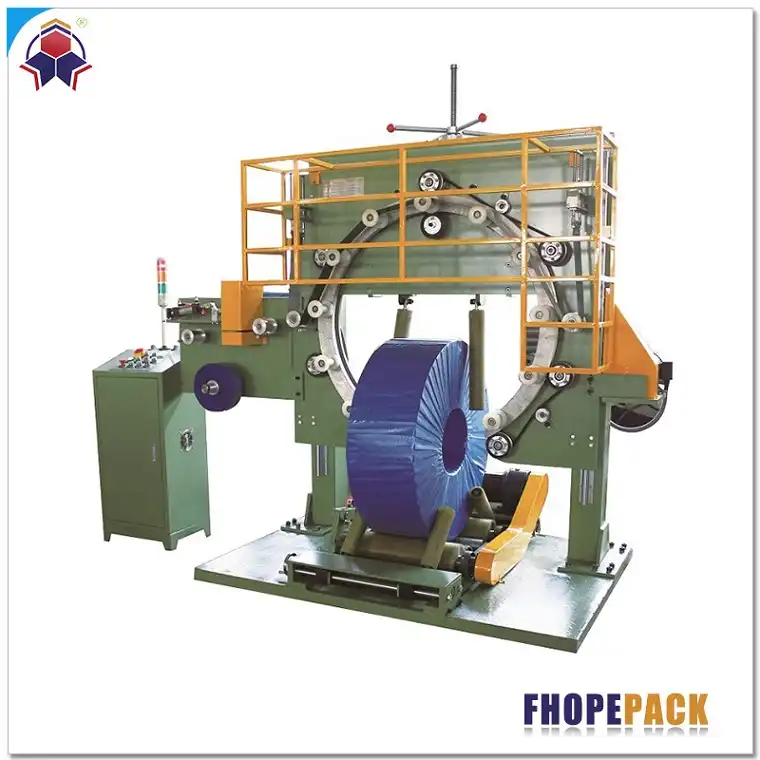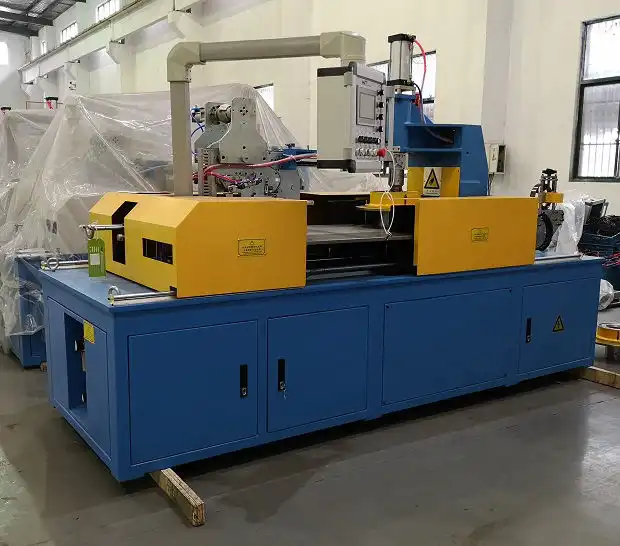Navigating the complexities of CE certification is crucial for exporting coil wrapping machines to Europe. Here’s an essential guide to understanding the requirements for CE marking in coil wrapping machines, ensuring your products meet the safety standards and can be sold in the EU.
Gaining access to the European market requires a comprehensive understanding of CE marking requirements. Compliance ensures your products are meet safety, health, and environmental standards dictated by the European Union (EU). This article provides an in-depth look at CE certification for coil wrapping machines, outlining the necessary directives, assessment procedures, and marking guidelines to navigate the process effectively.

What is CE Marking?
CE marking, derived from the French phrase "Conformité Européenne," is a mandatory conformity marking for certain products sold within the European Economic Area (EEA). It signifies that a product complies with the EU’s health, safety, and environmental protection standards. The CE marking is not a quality mark or an indication of origin but a declaration by the manufacturer that the product meets all applicable EU directives.
Key Benefits of CE Marking
- Market Access: Essential for selling coil wrapping machines within the EEA.
- Compliance: Demonstrates adherence to EU standards and regulations.
- Consumer Confidence: Builds trust among European customers.
- Legal Requirement: Necessary to avoid fines or product recalls.
Applicable EU Directives for coil wrapping machine
Coil wrapping machines could potentially fall under several EU directives, depending on their design, function, and intended use. Here’s a comprehensive list. A qualified consultant should be considered for a specific determination. Directive Description Application to Coil Wrapping Machine Machinery Directive 2006/42/EC Addresses the health and safety requirements for machinery, including design, construction, and safe operation. Most likely applicable to coil wrapping machines due to their mechanical and automated functions. Focuses on risk assessment, safety features, and documentation. Low Voltage Directive (LVD) 2014/35/EU Covers electrical equipment designed for use within certain voltage limits, ensuring electrical safety. Applicable if the coil wrapping machine operates within the specified voltage range, focusing on worker and service safety from electrical hazards. EMC Directive 2014/30/EU Regulates the electromagnetic compatibility of equipment, ensuring that it does not cause or is not susceptible to electromagnetic disturbance. Relevant if the coil wrapping machine contains electronic components that could emit or be affected by electromagnetic interference. RoHS Directive 2011/65/EU Restricts the use of hazardous substances in electrical and electronic equipment. Applicable if the coil wrapping machine contains electrical or electronic components, ensuring compliance with restrictions on substances like lead, mercury, and cadmium. Ecodesign Directive 2009/125/EC Establishes a framework for setting ecodesign requirements for energy-related products. May apply if the coil wrapping machine is considered an energy-related product, focusing on improving energy efficiency and reducing environmental impact.
The CE Certification Process in coil wrapping machine: A Step-by-Step Guide
The path to CE marking involves distinct stages, ensuring each product complies with relevant regulations.
- Identify Applicable Directives: Determine which EU directives apply to your coil wrapping machine. This depends on the product’s characteristics and intended use.
- Verify if a notified body is needed: Check the directives that apply to your machine and verify if these directives require that your product’s design is examined by a Notified Body.
- Conformity Assessment: Ensure the coil wrapping machine meets all essential requirements of the applicable directives. This often involves comprehensive testing and evaluation.
- Technical Documentation: Compile a comprehensive technical file, including:
- Product description
- Technical drawings
- Risk assessment reports
- Test reports
- User manuals
- Declaration of Conformity (DoC): Draft and sign an EU Declaration of Conformity, declaring that the coil wrapping machine meets all requirements. Only the original manufacturer or its authorized representatives are allowed to sign this.
- CE Marking: Affix the CE marking visibly, legibly, and indelibly onto the coil wrapping machine or its data plate. If this is difficult, it can be placed on the packaging and accompanying documents.
Detailed requirements of a Declaration of Conformity
The EU Declaration of Conformity is a legal document where a product’s manufacture states that the product meets all applicable EU laws. Specific details needed are:
- Name and address of the manufacturer or authorized representative.
- Description of the product, including model and serial number.
- A list of the EU directives the product complies with.
- References to the harmonized standards used.
- The name and identification number of the Notified Body involved, if applicable.
- A legally binding signature on behalf of the manufacturer.
- Date of issue.
The Role of Notified Bodies
Notified Bodies are independent third-party organizations designated by EU member states to assess product conformity. They are essential when a directive requires independent assessment, providing expertise and ensuring impartiality.
Key Functions of Notified Bodies
- Conformity Assessment: Evaluating products against relevant EU directives.
- Testing and Certification: Conducting tests and issuing certificates of compliance.
- Expertise: Providing specialized knowledge.
Affixing the CE Marking
The CE marking must be affixed clearly and visibly on the product. The marking should be indelible and placed where it is easily seen. If it’s impossible to affix the marking directly to the product, it may be placed on the packaging.
Guidelines for Affixing the CE Marking
- Visibility: The CE marking must be easily visible.
- Legibility: The CE marking must be readable, maintaining its original proportions.
- Durability: Be designed to withstand normal handling during the use of the product.
- Size Limitations: The CE marking must be at least 5 millimeters in height unless specified differently in the relevant product requirements.
Market Surveillance and Enforcement
European authorities monitor products within the EU market to enforce compliance with CE marking requirements. Noncompliant products can be subject to fines, market withdrawal, or even import bans.
How surveillance is performed:
Each country’s market surveillance authority is able to initiate actions outside the coordinated surveillance initiatives conducted by the Administrative Cooperation group. However, local authorities are still responsible for conducting investigations in the product sectors in which they occur. AdCo members meet several times per year at the EU level to share information and coordinate action plans for each sector. The European Commission then releases the results of these initiatives to all EU member states, authorities and citizens.
Avoiding Common Pitfalls in CE Marking
| Ensuring compliance can be challenging. Manufacturers must be aware of common mistakes that can lead to complications. | Type of Error | Explanation | Action to Avoid |
|---|---|---|---|
| Incorrect Directive Application | Applying wrong EU directives. | Conduct detailed assessments to identify applicable directives. | |
| Incomplete Technical File | Missing critical documents during the technical file process. | Ensure the technical file is complete with all required information. | |
| Inaccurate Declaration of Conformity | Errors in the declaration of conformity, leading to safety risks. | Thoroughly verify all details in the declaration of conformity before signing. | |
| Failure to Update Documentation | Failing to update all important documentation after changes to the law. | Document management system is critical to remain up with regulatory changes. | |
| Improper CE Marking Placement | CE mark too small, illegible or not in a permanent form. | Adhere strictly to guidelines for affixing the CE marking. |

